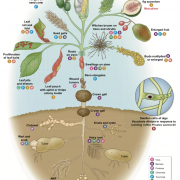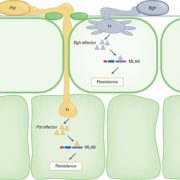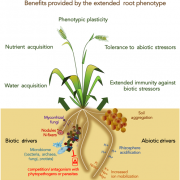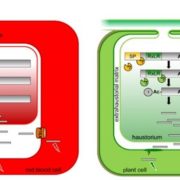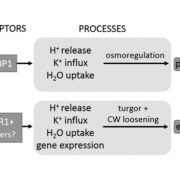A barley powdery mildew fungus non-autonomous retrotransposon encodes a peptide that supports penetration success on barley
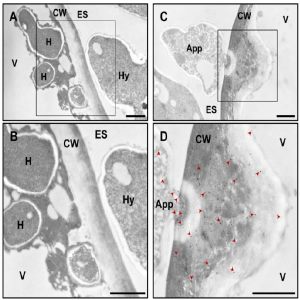 BioRxiv. Barley powdery mildew is an important asmocycete disease caused by the fungus Blumeria graminis f. sp. hordei. Previous literature in this field has investigated susceptibility genes as important targets to develop resistance. A well-known example of this, is the MLO gene, a negative regulator of basal resistance, loss of which is associated with mildew resistance. Another example is the small monomeric Rho of plants (ROP) GTPase HvRACB, whose constitutive activation supports haustorial growth into epidermal cells without the further induction of plant defence responses. In this work, Nottensteiner et al. have identified the HvRACB interacting Bgh protein ROP- interactive peptide 1 (ROPIP1) that is incoded on the Bgh SINE like retroposon Eg-R1. This newly identified intracellular virulence factor enhances Bgh growth in the epidermal cells when expressed transiently by particle bombardment. The protein is detectable in Bgh infected barley extracts and seen to be in hyphal structures and host cell cytoplasm when analysed by Transmission Electron Microscopy (TEM). RORPIP1 is recruited to the cortical microtubules by HvRACB modulator HvMAGAP1 and causes microtubule network destabilization. (Summary by Amey Redkar) BioRxiv. 10.1101/242271
BioRxiv. Barley powdery mildew is an important asmocycete disease caused by the fungus Blumeria graminis f. sp. hordei. Previous literature in this field has investigated susceptibility genes as important targets to develop resistance. A well-known example of this, is the MLO gene, a negative regulator of basal resistance, loss of which is associated with mildew resistance. Another example is the small monomeric Rho of plants (ROP) GTPase HvRACB, whose constitutive activation supports haustorial growth into epidermal cells without the further induction of plant defence responses. In this work, Nottensteiner et al. have identified the HvRACB interacting Bgh protein ROP- interactive peptide 1 (ROPIP1) that is incoded on the Bgh SINE like retroposon Eg-R1. This newly identified intracellular virulence factor enhances Bgh growth in the epidermal cells when expressed transiently by particle bombardment. The protein is detectable in Bgh infected barley extracts and seen to be in hyphal structures and host cell cytoplasm when analysed by Transmission Electron Microscopy (TEM). RORPIP1 is recruited to the cortical microtubules by HvRACB modulator HvMAGAP1 and causes microtubule network destabilization. (Summary by Amey Redkar) BioRxiv. 10.1101/242271


